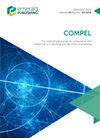An Active Split-Phase Control Technique for Hybrid Switched-Capacitor Converters Using Capacitor Voltage Discontinuity Detection
IF 1
4区 工程技术
Q4 COMPUTER SCIENCE, INTERDISCIPLINARY APPLICATIONS
Compel-The International Journal for Computation and Mathematics in Electrical and Electronic Engineering
Pub Date : 2023-06-25
DOI:10.1109/COMPEL52896.2023.10221011
引用次数: 1
Abstract
Hybrid switched-capacitor (SC) converters have gained popularity due to their efficient switch utilization and use of energy-dense capacitors, which allows them to achieve high efficiency and power density even at large conversion ratios. The Dickson converter is one such popular hybrid SC converter, as it can achieve the theoretical minimum switch stress rating for a given operating condition. However, unlike other hybrid SC topologies that can automatically achieve full soft-charging through the addition of one or more augmenting inductors, certain Dickson variants also require the use of special switching schemes to fully soft-charge all flying capacitors. This technique, denoted as split-phase switching, inserts extra sub-phases into the control scheme so that flying capacitors are disconnected or connected at staggered times. Traditionally, split-phase timing has been calculated analytically, sometimes using imprecise models. This paper instead proposes an active control technique for detecting hard-charging events on the flying capacitors, such that the split-phase timing automatically converges on soft-charging operation. The technique is validated on an 8-to-1 resonant single-inductor Dickson hardware prototype. While this method is demonstrated on a resonant fixed-ratio converter in this work, the technique can also be applied to regulating split-phase applications, as well as used to detect hard-charging events in general.基于电容电压断续检测的开关电容混合变换器有源分相控制技术
混合开关电容器(SC)变换器由于其高效的开关利用率和能量密度电容器的使用而受到欢迎,这使得它们即使在大转换比下也能实现高效率和功率密度。迪克森变换器是这样一个流行的混合SC变换器,因为它可以达到理论最小的开关应力额定值为给定的操作条件。然而,与其他混合SC拓扑不同,通过添加一个或多个增强电感器可以自动实现完全软充电,某些Dickson变体还需要使用特殊的开关方案来对所有飞行电容器进行完全软充电。这种技术称为分相开关,在控制方案中插入额外的分相,使飞行电容器在交错时间断开或连接。传统上,分相时序是解析计算的,有时使用不精确的模型。本文提出了一种检测飞行电容器硬充电事件的主动控制技术,使分相定时自动收敛于软充电操作。该技术在8比1谐振单电感Dickson硬件样机上进行了验证。虽然该方法在谐振固定比变换器上进行了演示,但该技术也可以应用于调节分相应用,以及用于检测一般的硬充电事件。
本文章由计算机程序翻译,如有差异,请以英文原文为准。
求助全文
约1分钟内获得全文
求助全文
来源期刊

CiteScore
1.60
自引率
0.00%
发文量
124
审稿时长
4.2 months
期刊介绍:
COMPEL exists for the discussion and dissemination of computational and analytical methods in electrical and electronic engineering. The main emphasis of papers should be on methods and new techniques, or the application of existing techniques in a novel way. Whilst papers with immediate application to particular engineering problems are welcome, so too are papers that form a basis for further development in the area of study. A double-blind review process ensures the content''s validity and relevance.
 求助内容:
求助内容: 应助结果提醒方式:
应助结果提醒方式:


